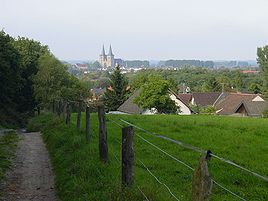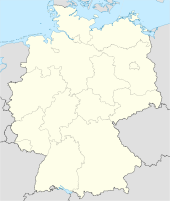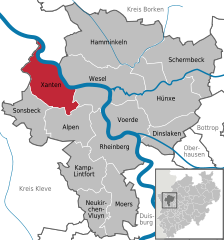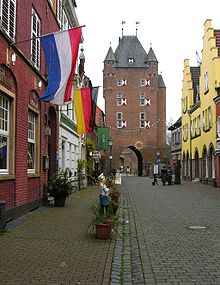- Xanten
-
Xanten 
Coordinates 51°39′44″N 6°27′14″E / 51.66222°N 6.45389°ECoordinates: 51°39′44″N 6°27′14″E / 51.66222°N 6.45389°E Administration Country Germany State North Rhine-Westphalia Admin. region Düsseldorf District Wesel Town subdivisions 6 Stadtbezirke Mayor Christian Strunk (CDU) Basic statistics Area 72.39 km2 (27.95 sq mi) Elevation 50 m (164 ft) Population 21,572 (31 December 2010)[1] - Density 298 /km2 (772 /sq mi) Other information Time zone CET/CEST (UTC+1/+2) Licence plate WES Postal code 46509 Area codes 0 28 01 und 0 28 04 (Marienbaum) Website www.rathaus-xanten.de Xanten (German pronunciation: [ˈksantən], Lower Franconian Santen) is a historic town in the North Rhine-Westphalia state of Germany, located in the district of Wesel.
Xanten is known for the Archaeological Park or archaeological open air museum (one of the largest in the world), its medieval picturesque city centre with Xanten Cathedral and many museums, its large man-made lake for various watersport activities as well as high standard of living. It is visited by approximately one million tourists a year. Big events include the Xantener Sommerfestspiele (a prestigious classical music festival lasting 2 weeks every summer), the annual Xantener Montmartre where artists from all over the world show their latest works as well as the annual German sandcastle-building championship.
Xanten is one of Germany's most affluent communitites[citation needed].
Contents
Geography
Xanten, the only German town whose name begins with X, is made up of three districts: Hochbruch, Niederbruch, and the city centre. Other localities belonging to the city of Xanten include Birten, Lüttingen, Marienbaum, Vynen, Obermörmter, Wardt, Mörmter, Willich, Beek, and Ursel. Parts of a nature reserve called Bislicher Insel belong to the city as well.
The city borders the Lower Rhine and the city of Rees to the north, the city of Wesel to the east, the municipalities of Alpen and Sonsbeck to the south, and the cities of Uedem and Kalkar to the west.
The closest international (European) airport is Airport Weeze, (also called Niederrhein Airport; Ryanair hub) is in Weeze (25 km); the closest intercontinental airport is Düsseldorf International Airport (60 km)
History
Antiquity
First settlements by isolated tribes can be dated around the year 2000 BC. Around 15 BC the Roman camp Castra Vetera was created on the Fürstenberg near today's locality Birten. It was intended as a base for campaigns into Germania and until its destruction during the Revolt of the Batavi in 70 AD it was occupied by 8,000 to 10,000 legionaries, and was the main base of the Classis germanica.
After the destruction of Castra Vetera a second camp became established at the Bislicher Insel, named Castra Vetera II, which became the base camp of Legio VI Victrix. A nearby created settlement, which was inhabited by 10,000 to 15,000 usually former legionaries, was given the rights of a Colonia in 110 by the Roman emperor Marcus Ulpius Traianus, who renamed the city into Colonia Ulpia Traiana. The colonia became the second most important commercial post in the province of Germania Inferior, only surpassed by Colonia Agrippinensis (today's Cologne). In 122, Vetera II became the camp of Legio XXX Ulpia Victrix, which substituted VI Victrix which had moved to Britannia.
In 275 the colonia was almost destroyed by Germanic tribes. Thereupon in its neighborhood a new city was established, named Tricensimae, which was smaller but fortified and more easily defended. At the beginning of the 5th century, assaults by Germanic tribes rapidly increased, with the result that the colonia' was finally given up.
In 363 The Christian Viktor of Xanten is supposed to have been executed together with 360 further members of the Theban Legion near the modern town of Birten, as they refused to sacrifice to the Roman gods. Since then Viktor of Xanten has been declared a martyr by the Roman Catholic Church, and the patron saint of the cathedral established over his assumed burial place.
Middle Ages
In the 5th century the Franks began to settle in the area of today's Xanten, but they did not find any urban settlements.
According to the legend of the Nibelungs, Siegfried of Xanten was born on ze Santen an dem Rhîne.
In the second half of the 8th Century a church was built on the grounds of an old cemetery of the ancient Roman colony and called Sanctos (super Rhenum) (also mentioned as ad Sanctum). The name of "place of saints" was derived from the assumed grave of the martyr Viktor of Xanten and is the source of today's city name of Xanten. After the establishment of a convent to the south, what became today's town centre grew into existence.
In 939 troops under Otto I, King of Germany defeated rebellious Franconian, Saxon and Lotharingian troops under Eberhard of Franconia in the Battle of Birten near Xanten. Following the Battle of Andernach the same year the Rhineland was reaffirmed to the kingdom of Otto I.
While Xanten, with its rich Viktor Convent, was still being besieged by the Norsemen in 863, in 1122 the place already appears as part of a trading network at the Lower Rhine. On July 15, 1228, Xanten was given city rights by the Archbishop of Cologne, Heinrich of Molenark.
Xanten had a Jewish community in early medieval times. Two massacres of Jews occurred during the First Crusade, on (June 1 and 27, 1096). On the latter occasion some Jews committed suicide in order to escape the fury of the Crusaders.[citation needed]
In 982 the foundation stone for the Gothic St. Victor cathedral was laid. After 281 years of construction it was finally completed in 1263. At the end of the 14th Century, Xanten was surrounded by a city wall.
In 1392 the northern part of the city came into the possession of the dukes of Cleves, while the southern part was still possessed by the Archbishopric of Cologne. The division of Xanten was a cause of a conflict between Cleves and Cologne, which ended when the whole of Xanten was awarded to the Duchy of Cleves in 1444.
Early Modern period
After being taken by the dukes of Cleves, in the wake of war and crop failure, the number of inhabitants slumped from 5,000 at the beginning of the 16th Century to approximately 2,500 by the end of the 18th Century. The Rhine had been a basis of Xanten's status as a trading city until the river bed shifted away from the city, causing its economic situation to deteriorate. The river even flooded and destroyed the locality of Birten several times.
The section Marienbaum, however, became the main place of pilgrimage on the Lower Rhine between 1430 and 1441. In 1460 a monastery of the Bridgettines was established, with an abbey church called St. Mariä Himmelfahrt (Assumption of Mary) which nowadays serves as a parish church.
In the 17th century Xanten was with Cleves inherited by the Margraviate of Brandenburg. Protestantism was placed on an equal footing with the Roman Catholic Church, as confirmed by the Treaty of Xanten on 12 November 1614. Thereupon a church was built at the Großer Markt (Great market place), which was expanded with a spire in 1622. Nevertheless, at the beginning of the 20th century only 5% of the population were of Protestant denomination. By the beginning of the 21st century, the Protestant population had increased to some 20%.
Modern times
In 1802 the Viktor-convent was secularized by Napoléon Bonaparte, and the libraries of closed monasteries and the convent library were merged. After this the economic situation deteriorated more rapidly. A city gate called the Marstor was torn down in 1821, and the Scharntor and parts of the city walls were removed in 1825. The removal of the Klever Tor and a mill called Kriemhildmühle was prevented by a city councillor in 1843. At the same time the ruins of the Colonia Ulpia Traiana, which had been used as a quarry since the Roman settlement was given up, aroused the interest of archaeologists.
Xanten was administered within the Prussian Rhine Province from 1822-1945. Between 1819 and 1844 excavation was carried out. In September,1927, the Catholic Church municipality celebrated its 1,600th anniversary; in 1937 Pope Pius XI granted the right for the cathedral of St. Viktor to be called a basilica minor.
In the later part of the 19th century the attention of the Jewish world was centred on the small congregation of Xanten because of a case of alleged ritual murder. On June 29, 1891, John Hegemann, the five-year-old son of a local cabinet maker, was found dead in a neighbour's barn, with his throat cut from ear to ear. Anti-Semitic agitation connected the Jewish butcher and former shoḥeṭ Adolf Buschoff with this crime; and the local priest, Father Bresser, lent support to this rumour by publishing articles on ritual murder in the paper Bote für Stadt und Land, which he edited. The agitation in the anti-Semitic press, as well as at anti-semitic meetings, where it was insinuated that the Jews had bribed or intimidated the authorities in order to prevent the discovery of the truth, compelled the government to arrest Buschoff and his family (October 14, 1891). The evidence against the man, who had always borne a good reputation, was so flimsy, however, that he was discharged (December 20). This action aroused the anti-Semites to still stronger agitation, which culminated in a heated debate in the Prussian Diet. In the course of this argument Stoecker, the ex-court chaplain, repeated the accusation of ritual murder, and hinted at Jewish influence as the cause of the failure to find the murderer (February 7, 1892). Under pressure from this agitation, Buschoff was rearrested (February 8), and tried before a jury at Cleves (July 4-14, 1892). During this trial it was found that the accusations were based on mere hearsay, and contained impossible assertions. The prosecuting attorney himself moved for the dismissal of the charge, and the jury rendered its verdict accordingly. The real murderer was never discovered, and the possibility that the death of the child was due to an accident was not entirely disproved. The agitation had the effect of reducing the Jewish population of the city, and Buschoff himself had to leave. In 1905 Xanten had about thirty Jews out of a total population of 3,770.[citation needed]
In 1933 mayor Heinrich Wagner was locked up in a tower called the Meerturm, accused of alleged nepotism in the loan business. His successor was Friedrich Karl Schöneborn, while the post of deputy mayor was given to Heinrich Prang junior. Prang had already created a local group of the NSDAP in 1925. As the local council of the Deutsche Zentrumspartei was dissolved, three of formerly eight city council members were group members of the NSDAP. The remaining opposition consisted of communists and liberal politicians lacking a clear political mandate.
The following years saw harassment of the Jewish population of Xanten. This included the destruction of the local prayer room and the devastation of several dwellings of Jewish inhabitants on November 9, 1938. After these events the entire Jewish population fled Xanten. During the Second World War an ammunition factory of the Luftwaffe was established in a small forest close to the city, called Die Hees. While citizens of Xanten worked there at the beginning of the war, women and children, and especially foreigners were forced to perform hard labour at the plant as the war progressed. Incidents in the area of the factory occurred in November, 1942, and October, 1944, causing the explosion of a portion of the stored ammunition, which cost several workers' lives. In May, 1940, the German 256th infantry division was transferred to Xanten to take part in the forthcoming invasion of the Netherlands.
When allied troops reached Xanten in February, 1945, mayor Schöneborn left the city. With him fled almost the entire city administration to areas to the east. In the same month the bombardment of the city had begun, killing civilians and destroying parts of Xanten. In addition, the cathedral was hit by bombs and damaged heavily. On March 8, 1945, Xanten was finally taken by Canadian troops. The Canadian military lost, according to their own data, 400 soldiers in the fight against the defending Wehrmacht's Fallschirmjäger (paratroops). Thereupon the city, 85% of which had been already been destroyed, was occupied by British troops while the population was evacuated to Bedburg-Hau in preparation for the crossing of the Rhine near the city of Wesel. Artillery projectiles fired by German soldiers from the right bank of the Rhine further devastated Xanten at this time. When the crossing of the Rhine on March 24, 1945, finally succeeded, the Second World War was over for Xanten.
The reconstruction of the city and the cathedral was accomplished particularly by the archaeologist and monument conservationist Walter Bader, and lasted until 1966. Expellees from eastern Prussia that were resettled in Xanten caused the population to rise by almost 40%. In the course of the local re-organization in 1969, the localities Birten, Lüttingen, Marienbaum, Obermörmter, Vynen and Wardt were integrated into Xanten, so that around 16,000 inhabitants lived within the city boundaries. The area of the city increased from 8 km² to 72 km².
In 1975 the Archäologischer Park Xanten (Archaeological Park Xanten), a partial reconstruction of the Roman Colonia Ulpia Traiana, was established and opened for tourism. It is built on the site of the Roman town. Today it is one of the most frequently visited parks in Germany. Among other events there even the popular TV-show Wetten dass..? has taken place in the APX. Further different historical buildings in the town centre were restored, and today in Xanten there is one of the most beautiful city centres in Germany, with many shops, restaurants and cafes in a medieval atmosphere. At the Xantener Südsee and Xantener Nordsee, two lakes connected by a channel close to the localities Wardt and Vynen, the Freizeitzentrum Xanten (Leisure center Xanten) was established in 1982. Today, it is a popular destination for sailors. On November 28, 1988 Xanten, received the title of a Staatlich anerkannter Erholungsort (state-recognized leisure city) as the first such city in the governmental district of Düsseldorf. Between 1990 and 2004 the number of inhabitants rose from 16.930 to about 22000. Xanten is twinned with Geel/Belgium, Saintes/France and Salisbury in the United Kingdom.
Among other schools there is one Gymnasium (Grmmar School), the Stiftsgymnasium Xanten, and a private school for girls, the Marienschule, in Xanten.
Xanten is also a popular filming location and the site of many concerts.
Xanten boasts the likes of Claudia Schiffer, José Carreras, Andre Rieu and Veronica Ferres as regular visitors and Xanten home owners.
Since Xanten is a quite wealthy town[citation needed], the conservative CDU dominates.
Seat distribution in the town council Party Number of seats CDU 19 SPD 9 Local Party FBI 5 B90/Grüne 3 FDP 2 Bibliography
- Aronius, "Regesten," p. 89, No. 188; p. 92, No. 195). In 1187 the martyrs of Neuss were brought to Xanten to be buried by the side of those martyred in 1096 (ib. p. 144, No. 322)
- Mittheilungen aus dem Verein zur Abwehr des Antisemitismus, 1892, Index, s.v. Xanten and Buschoff;
- Allg. Zeit. des Jud. 1892, Nos. 29-31;
- Der Prozess Buschoff, Leipsig, 1892;
- Nathan, Der Prozess Buschoff, Berlin, 1892;
- Der Prozess Xanten-Cleve, ib. 1892;
- Der Xantener Knabenmord vor dem Schwurgericht zu Cleve, 4-14 Juli, 1892, Berlin, 1893 (a complete stenographic record).
- Holger Schmenk: Xanten im 19. Jahrhundert. Eine rheinische Kleinstadt zwischen Tradition und Moderne (Köln / Weimar / Wien: Böhlau 2008).
References
- ^ "Amtliche Bevölkerungszahlen" (in German). Landesbetrieb Information und Technik NRW. 31 December 2010. http://www.it.nrw.de/statistik/a/daten/amtlichebevoelkerungszahlen/index.html.
This article incorporates text from the 1901–1906 Jewish Encyclopedia, a publication now in the public domain.
External links
- Xanten Home Page
- Virtual City Hall (German)
- Virtual Tour of Xanten City Centre
- Archaeological Park
- Leisure Center Xanten
- Livius.org: Colonia Ulpia Traiana (Xanten)
Alpen | Dinslaken | Hamminkeln | Hünxe | Kamp-Lintfort | Moers | Neukirchen-Vluyn | Rheinberg | Schermbeck | Sonsbeck | Voerde | Wesel | XantenCategories:- Towns in North Rhine-Westphalia
- 10s BC establishments
- Roman legions' camps in Germany
- Roman towns and cities in Germany
- Archaeological sites in Germany
- Populated places on the Rhine
Wikimedia Foundation. 2010.







